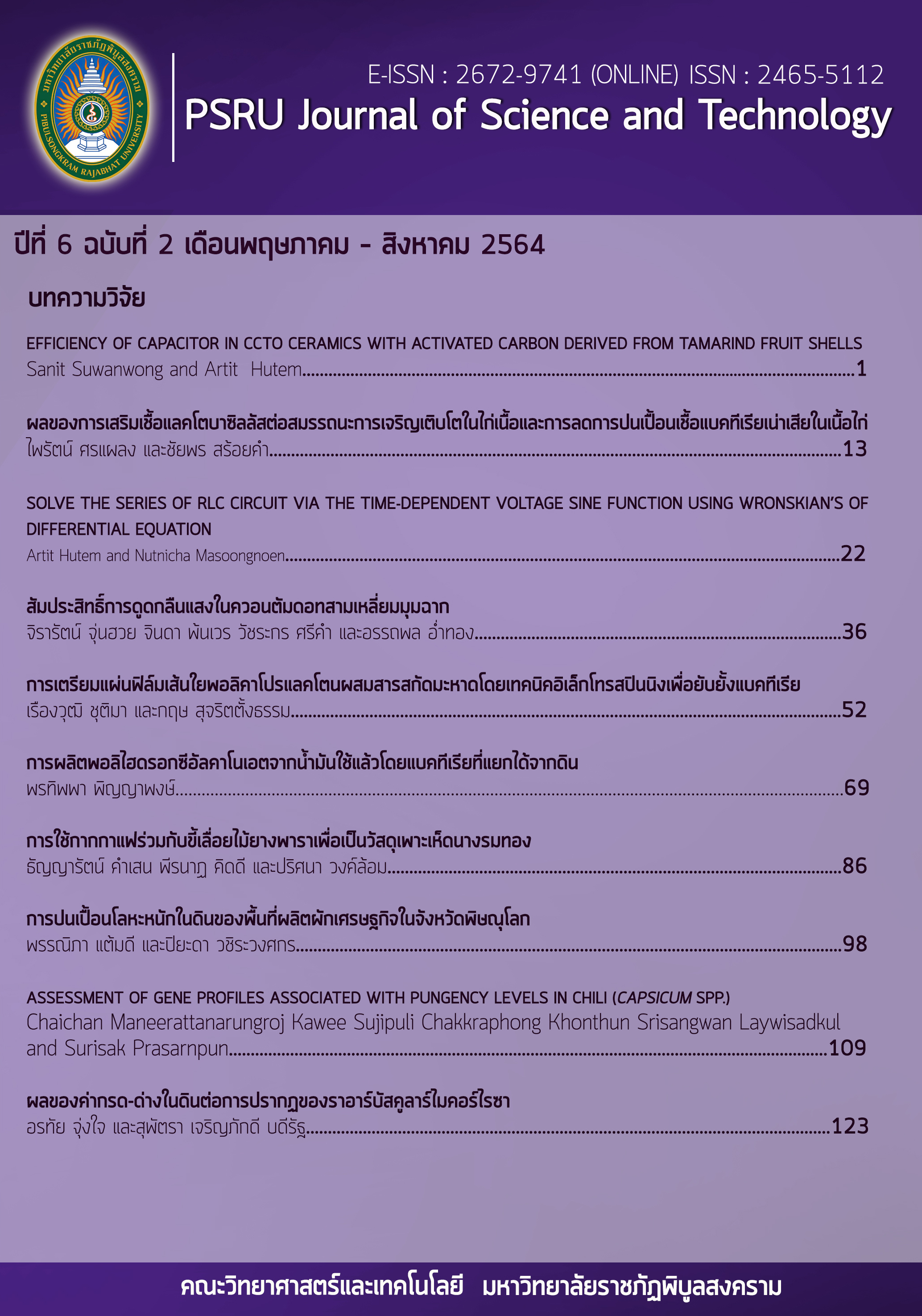ASSESSMENT OF GENE PROFILES ASSOCIATED WITH PUNGENCY LEVELS IN CHILI (CPASICUM SPP.)
คำสำคัญ:
Capsicum cultivars, Capsaicin biosynthesis, Pungencyบทคัดย่อ
Chili in the genus Capsicum is globally cultivated as an economic vegetable crop, and used in traditionally pungent cuisines, especially in Thailand. Degrees of pungency were positively correlated with capsaicin biosynthesis, which was strongly influenced by genotype and associated with several enzyme-encoding genes. Five candidate genes (PUN1, HCT, pAMT, CCR and KAS) responsible for capsaicin synthesis were assessed among fourteen Capsicum cultivars. Results showed that all putative capsaicin biosynthetic genes were present in five Capsicum cultivars of Bhut Jolokia, Orange Habanero (High pungency) and Tubtim Mordindang, Phet Mordingang and Akanee Pirote (Moderate pungency). Two genes (HCT and pAMT) were absent in all eight low pungent cultivars (Jindanil 80, Bang Chang, Yodson Khem 80, Num Khao Donyang, Num Keowtong 80, Hua-ruea, Huai Si Thon Kham Kaen and Chai Tai). Analysis of the capsaicin biosynthetic genes showed that Capsicum cultivar KKU-P28016 (breeding line from Khon Kaen University) contained PUN1, pAMT, CCR and KAS genes, suggesting identity as the moderately pungent Capsicum group. Mature fruit phenotypic traits among the studied Capsicum cultivars showed that a globose-oval shape of mature fruit was detected among highly and moderately pungent Capsicum cultivars, while an elongated shape of mature fruit was observed in low pungent cultivars. High correlation between the phenotypic trait of mature fruit shape and gene profiles is a powerful tool to discriminate pungency levels in Capsicum cultivars.
เอกสารอ้างอิง
Agarwal, P., Das, C., Dias, O., & Shanbhag, T. (2017). Antimicrobial property of capsaicin. Int Res J Biol Sci, 6(7), 7–11.
Arce-Rodríguez, M.L., & Ochoa-Alejo, N. (2019). Biochemistry and molecular biology of capsaicinoid biosynthesis: recent advances and perspectives. Plant Cell Rep, 38, 1017–1030.
Basith, S., Cui, M., Hong, S., & Choi, S. (2016). Harnessing the therapeutic potential of capsaicin and its analogues in pain and other diseases. Molecules, 21(8), 966.
Burgos-Valencia, E., Echevarría-Machado, I., Narváez-Zapata, J.A., & Martínez-Estévez, M. (2020). Gene expression related to the capsaicinoids biosynthesis in the Capsicum genus: Molecular and transcriptomic studies. Braz J Bot, 43, 201–212.
Bogusz, S., Libardi, S., Dias, F.G., Coutinho, J., Bochi, V., Rodrigues, D., Melo, R., & Godoy, H. (2018). Brazilian Capsicum peppers: capsaicinoids content and antioxidant activity. J Sci Food Agr, 98(1), 217-224.
Clark, R., & Lee, S.H. (2016). Anticancer properties of capsaicin against human cancer. Anticancer Res, 36, 837–844.
Guillen, N.G., Tito, R., & Mendoza, N.G. (2018). Capsaicinoids and pungency in Capsicum chinense and Capsicum baccatum fruits. Goiânia, 48(3), 237–244.
Guzmán, I., & Bosland, P.W. (2017). Sensory properties of chile pepper heat-and its importance to food quality and cultural preference. Appetite, 117, 186–190.
Jolayemi, A.T., & Ojewole, J. (2013). Comparative anti-inflammatory properties of capsaicin and ethylacetate extract of Capsicum frutescens Linn. [Solanaceae] in rats. Afr Health Sci, 13(2), 357–361.
Lang, Y., Kisaka, H., Sugiyama, R., Nomura, K., Morita, A., Watanabe, T., Tanaka, Y., Yazawa, S. & Miwa, T. (2009). Functional loss of pAMT results in biosynthesis of capsinoids, capsaicinoid analogs, in Capsicum annuum Cv. CH-19 Sweet. Plant J., 59, 953–961.
Marini, E., Magi, E., Mingoia, M., Pugnanoli, A., & Facinelli, B. (2015). Antimicrobial and anti-virulence activity of capsaicin against erythromycin-resistant, cell-invasive group A Streptococci. Front Microbiol, 6, 1281.
Naves, E.R., de Ávila, S.L., Sulpice, R., Araújo, W.L.,Nunes-Nesi, A., Peres, L.E.P. & Zsögön, A. (2019). Capsaicinoids: pungency beyond Capsicum. Trends Plant Sci, 24, 109–120.
Ogawa, K., Murota, K., Shimura, H., Furuya, M., Togawa, Y., Matsumura, T., & Masuta, C. (2015). Evidence of capsaicin synthase activity of the Pun1-encoded protein and its role as a determinant of capsaicinoid accumulation in pepper. BMC Plant Biol,15, 93.
Othman, A.Z.A.A., Ahmed, Y.B.H., Habila, M.A., & Ghafar A.A. (2011). Determination of capsaicin and dihydrocapsaicin in Capsicum fruit samples using High Performance Liquid Chromatography. Molecules, 16(10), 8919–8929.
Popelka, P., Jevinová, P., Šmejkal, K., & Roba, P. (2017). Determination of capsaicin content and pungency level of different fresh and dried chilli peppers. Folia Vet, 61(2), 11–16.
Prasad, B.C.N., Gururaj, H.B., Kumar, V., Giridhar, P., Parimalan, R., Sharma, A., & Ravishankar, G.A. (2006). Influence of 8-methyl-nonenoic acid on capsaicin biosynthesis in in-vivo and in-vitro cell cultures of Capsicum spp. J Agr Food Chem, 54, 1854–1859.
Puripunyavanich, V., Suwan, N., Nanan, T., & Sutthanukul, P. (2019). Discover of giant chili in Nan Province, Thailand. Proc Int Conf Biodiver, IBD2019, 1–4.
Reddy, U.K., Almeida, A., Abburi, V.L., Alaparthi, S.B., Unselt, D., Hankins, G., Park, M., Choi, D, & Nimmakayal, P. (2014). Identification of gene-specific polymorphisms and association with capsaicin pathway metabolites in Capsicum annuum L. collections. PLOS ONE, 9(1), e86393.
Sarpras, M., Gaur, R., Sharma, V., Chhapekar, S.S., Das, J., Kumar, A., Yadava, S.K., Nitin, M., Brahma ,V., Abraham, S.K., & Ramchiary, N. (2016). Comparative analysis of fruit metabolites and pungency candidate genes expression between BhutJolokia and other Capsicum species. PLOS ONE,11(12), e0167791.
Stewart, C.J., Kang, B.C., Liu, K., Mazourek, M., Moore, S.L., Yoo, E.Y., Kim, B.D., & Paran, I. (2005). The Pun1 gene for pungency in pepper encodes a putative acyl transferase. Plant J., 42, 675–688.
Tanaka, Y., Nakashima, F., Kirii, E., Goto, T., Yoshida, Y., & Yasuba, K. (2017) Difference in capsaicinoid biosynthesis gene expression in the pericarp reveals elevation of capsaicinoid contents in chili peppers (Capsicum chinense). Plant Cell Rep, 36(2), 267–279.
Tsurumaki, K., & Sasanuma, T. (2019). Discovery of novel unfunctionalpAMT allele pamt10 causing loss of pungency in sweet bell pepper (Capsicum annuum L.). Breeding Sci,69, 133–142.
Werner, J. (2021). Capsaicinoids – Properties and Mechanisms of Pro-health Action. In: Jeszka-Skowron M., Zgoła-Grześkowiak A., Grześkowiak T., & Ramakrishna A. (Eds.), Analytical Methods in the Determination of Bioactive Compounds and Elements in Food. In Food Bioactive Ingredients. (pp. 193-225). Switzerland: Springer, Cham.
Zheng, J., Zheng, S., Feng, Q., Zhang, Q., & Xiao, X. (2017). Dietary capsaicin and its anti-obesity potency: from mechanism to clinical implications. Biosci Rep, 37(3), BSR20170286.
ดาวน์โหลด
เผยแพร่แล้ว
รูปแบบการอ้างอิง
ฉบับ
ประเภทบทความ
สัญญาอนุญาต
กองบรรณาธิการขอสงวนสิทธิ์ในการปรับปรุงแก้ไขตัวอักษรและคำสะกดต่างๆ ที่ไม่ถูกต้อง และต้นฉบับที่ได้รับการตีพิมพ์ในวารสาร PSRU Journal of Science and Technology ถือเป็นกรรมสิทธิ์ของคณะวิทยาศาสตร์และเทคโนโลยี มหาวิทยาลัยราชภัฏพิบูลสงคราม และ
ผลการพิจารณาคัดเลือกบทความตีพิมพ์ในวารสารให้ถือมติของกองบรรณาธิการเป็นที่สิ้นสุด







